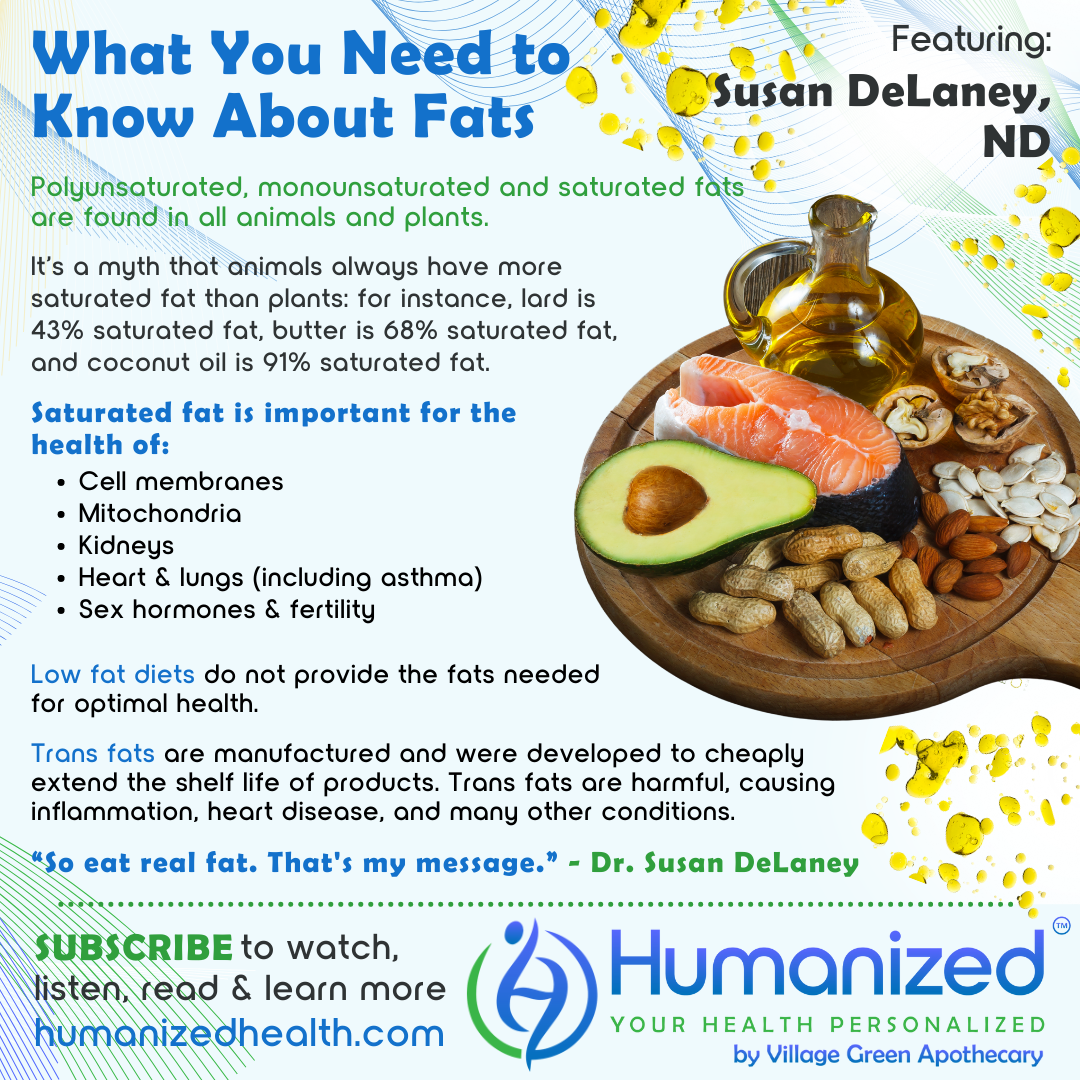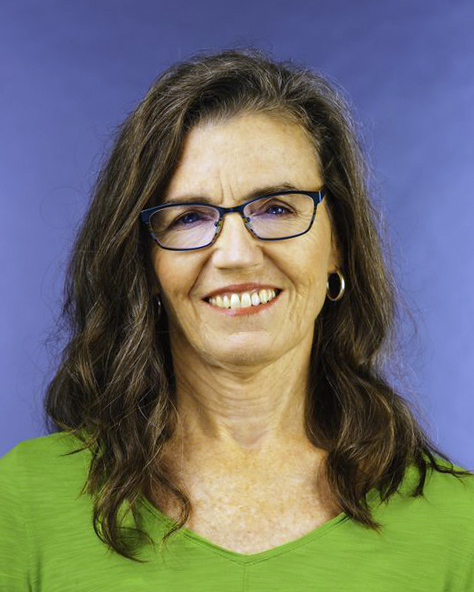What You Need to Know About Fats
Featuring
Susan DeLaney, ND, RN
WATCH
LISTEN
READ
Rebekah Kelley: Welcome to the Humanized Podcast, all about personalizing your health. I’m your host, Rebekah Kelley, and today, Dr. Susan DeLaney will be sharing her expertise on the topic, What You Need to Know About Fats. Remember to access other Humanized Health podcasts by subscribing to get all of the other variety of casts in audio, video, and transcription at HumanizedHealth.com. I’d also like to thank our lead sponsor, Village Green Apothecary, at MyVillageGreen.com.
Today’s guest, Dr. Susan DeLaney, has practiced naturopathic medicine in North Carolina for over three decades. Over the years, she’s observed that the health of many people, including children, has greatly declined, while the number of prescriptions has dramatically increased. By using a natural approach to healing, she’s able to help people become less dependent on prescription drugs and improve their health and vitality. In her practice as well as in her lectures, Dr. DeLaney inspires people using up-to- date nutrition science to take personal responsibility for their own health journey.
Dr. DeLaney is passionate about educating individuals and their healthcare providers about the benefits of advanced nutrient therapy for balancing biochemistry, as well as the nutritional value of eating real food and healthy fats. Dr. DeLaney’s latest project, Your Health is No Big Thing, It’s a Million Little Things, provides links to 13 educational videos to help people learn more about healthy fats, the importance of fat-soluble vitamins, as well as simple changes individuals can make to improve their health.
Dr. DeLaney, it’s so wonderful to have you back with us.
Susan DeLaney: Thank you. Glad to be here. I love talking about fats.
Rebekah Kelley: Well, there’s so many mixed messages about fats. Are they good for you? Are they bad for you? There’s also, it seems to be, different kinds of fats. People use different terms like saturated fats, unsaturated fats, trans fats. So I am so excited for us to be able to unpack the subject and have a better understanding so that we can make better choices for maximum health. So thank you so much for being here to help us understand.
So let’s just jump right in. What is a fat and what is it made of?
Susan DeLaney: Well, actually, a fat is made up of only three things: carbon, hydrogen, and oxygen, and that’s it. Every single fat that you have, saturated, unsaturated, polyunsaturated, they’re only made up of carbon, hydrogen and oxygen. And, I’ll show you a little picture [holds up diagram]. This is what stearic acid looks like. And so the carbon – I’m just doing one of them – and so the carbon is the black and connected to that you have hydrogens, and then the carbons are connected to each other by one arm. And on the end you have two oxygen, a carbon and a hydrogen, COOH, and that makes it an acid. So that’s what you call a fatty acid. And so that’s what fats are technically called.
But this is a saturated fat because it is linked by single bonds, carbon to carbon, single bonds, and there are no double bonds in there. So what’s the difference between that saturated and unsaturated? Do you want to know that one?
Rebekah Kelley: I do want to know. Yes. I’m anxious to see.
Susan DeLaney: Yeah. So in the second one [showing lower part of diagram], you can see that that is unsaturated fat, and that’s oleic acid. It has one double bond right here, and that double bond changes it and allows it to have a kink in the chain. And that kink is interesting because it makes it more semi-solid, whereas this one [pointing to diagram of stearic acid] is a solid fat, and you would see this in butter and lard, and fats that get hard at room temperature.
Coconut oil is a saturated fat. So the only difference between saturated fat and unsaturated fat is that double bond. That’s it. And if you have one double bond, which you did in that one, you have oleic acid, and that’s called a monounsaturated fat. If you have two or three, that’s a polyunsaturated fat. And all of those are found in nature, saturated and unsaturated as well.
Rebekah Kelley: So then the concept of saturated fats being from animals and unsaturated fats from plants would not, that’s not going to hold true then, right?
Susan DeLaney: Absolutely not. That’s not…
Rebekah Kelley: You said butter and then you said coconut oil, or coconut fat – I’m sorry. So those are one animal, one plant.
Susan DeLaney: Exactly. All plants and animals contain both saturated and unsaturated fatty acids.
So I’m going to stick this little chart up [holds up chart of different dietary fats] and I’m not sure you can see it very well, but the code is down at the bottom, and it shows examples of plants and animals and the difference in the saturated fats and the unsaturated fats. And in this chart, you’ll notice that coconut oil, which is a plant, comes from a plant, is the most saturated fat in the entire realm of fats. Even more so than butter.
Rebekah Kelley: Wow.
Susan DeLaney: People don’t understand that. And so lard is only 43% saturated fat and butter is 68% saturated fat. And coconut oil is 91% saturated fat.
Rebekah Kelley: Wow.
Susan DeLaney: And so all these different colors [on the chart] represent the different types of fats, and we won’t go into that. Polyunsaturated fats and saturated and monounsaturated fats are found in every single animal or plant. And it’s kind of shocking to realize that animals sometimes have less than some of the plants, like the lard and the butter have less than palm oil and coconut oil. So that’s an interesting fact. People should break that myth. You cannot separate it [types of fats] with plants and animals. Both have different levels of each one of them. And in the tropical plants, they use it because it makes the leaves a little stiff and protected from the wind and the sun. And in animals, it’s just a combination of those things. It comes from the grass, actually, that they then make them. The animal makes saturated fat.
Rebekah Kelley: What makes saturated fats so important to us? What’s the big deal then about saturated fats?
Susan DeLaney: Well, every cell in your body, every single cell has a membrane around it. Actually, I have one [a diagram], and this is a cut through of a cell. And these are the fatty acid tails, these little things right here. That’s a phospholipid, but the cell membrane is made of lipids. And so your body cells need to have 50% saturated fats in order for that cell membrane to work properly. And some people call the cell membrane the mem-brain, B R A I N, because if you think about, it keeps certain things in and certain things out and it’s really protective. And it has receptors in it, lets enzymes connect, all kinds of things.
And so the membrane is a really, really important thing. It also is the membrane of your mitochondria. When people are talking about mitochondrial dysfunction, some of that is a lack of saturated fats, not just those mineral things. Your kidneys and your heart prefer to operate with saturated fats. They have fats around them, surrounding the organ itself, and it’s really essential for their operation. Your sex hormones are manufactured from saturated fats. That’s important.
Rebekah Kelley: That’s really important.
Susan DeLaney: We have some problems with fertility and hormonal levels in this country, and some of that is the lack of saturated fats.
And then surfactant, which is in your lungs, is an important substance that helps keep things moving really well. So, like kids with asthma, if you have a diet high in saturated fats like butter and cheeses and whole milks, they have fewer problems with asthma than children who are eating other types of oil in their diet. So that is significant, as well.
Rebekah Kelley: Wow. That’s something that actually I don’t hear on the regular kind of everyday marketing materials. I always hear “low fat” and I even see “low fat” on kids’ food.
Susan DeLaney: Yeah.
Rebekah Kelley: But that’s counter to what you’re just saying, that they need it actually as they’re developing, for certain aspects of their body, right?
Susan DeLaney: Exactly.
Rebekah Kelley: To grow. So I have to ask you about trans fats also, right? Where do they come from? Why do we have them? You know, you certainly hear a lot about wanting to reduce them. And I do notice that sometimes on the back of products, they tell you how many trans fats there are. But what’s going on with that? Talk to us.
Susan DeLaney: So trans fats are mostly all manufactured. You can find some in nature, but rarely, in milk kind of products. But trans fats were developed so you could keep your products on the shelf longer. Your cookie could stay on the shelf for 6 months. That doesn’t happen when you have real fats, it’s more of a breakdown. So it keeps a long shelf life, plus it’s cheaper. You can take soybean oil or corn oil, anything that is easy to produce, and then put it through a process called hydrogenation, which uses some nickel and other substances to do that, and then make that fat behave just like butter and lard.
So I’m going to show you a picture of this [holds up a diagram]. This one is a saturated fat – we just saw this stearic acid – so it doesn’t bend. This is oleic acid, it bends easily. And what they do is make this unsaturated fat not bendable. So that’s what a trans fat is, a corn oil, soybean oil that was bendable, because see the kink in there?
Rebekah Kelley: Right.
Susan DeLaney: And they do a process that now makes it behave like butter. So you can make those pie crusts and pastries that hold together better instead of slogging down.
Rebekah Kelley: So it sounds like what you’re saying to me, if I’m understanding, is that it’s basically shelf stable, right? It’s a longer process to break down, but what I understand…
Susan DeLaney: It’s also cheaper. It’s much cheaper to have a trans fat.
Rebekah Kelley: So, shelf stable, cheaper, because its being manufactured, right? It’s not coming from an animal or plant, it sounds like.
Susan DeLaney: Well, eventually, I mean. Originally it comes from soy or corn, but then they change the structure of it and it looks just like it, but biochemically it does not behave the same way. So it keeps all the food, like lard or butter would, holding together, gives it better texture and structure.
Rebekah Kelley: So whenever you think about fat… Like, I know I have an app, I track all my food, right? And so when I put it in, I see it breaks it down into your carbs, your fats, your protein, right? So you’re looking at your fats. And the things that you shared about, like what parts of your body really need that fat to operate maximally, and we know that the message has been going up for some time now, right? Low fat, no fat…
Susan DeLaney: Mm-hmm.
Rebekah Kelley: This is what you need to do to lose weight, to be healthier. You’re kind of giving me a message that that might not quite be accurate. Can you help us understand what’s been happening? I know you shared with me, and I don’t know if maybe it’s appropriate to share with the viewers, the message around, like whenever we started getting the message about low fat, no fat. I know we know that weight has actually gone up since then, right? So that message, do you have that? Can you show that?
Susan DeLaney: Yes. Yes. So this is a chart that shows when the US Department of Agriculture introduced the low fat diet. They thought it was healthier, actually. And since that time, Americans have been getting fatter and fatter and fatter in all of those age groups. You might not be able to see the numbers, but every single…
Rebekah Kelley: The lines go right up. And what, if you can lift it a little bit higher, Dr. DeLaney, what was the number of whenever we started saying that, 1976, 1980, looks like?
Susan DeLaney: 1986, or something like that. Actually, they were starting to push it way before that, and low fat was coming in. And so again, when you have low fat, you’re not getting the nutrients that you need that we discussed earlier. And so that is really a problem. And that’s what’s happening with these trans fats. You’re substituting fake oils into your membranes, into your sex hormones that do not operate well. So they hold the space, but they’re not functional. They don’t have the same ability to work. So you’re having breakdown of your cells on a microscopic level all the time. And people are dying younger and younger of heart attacks, diabetes, hypertension in their 40s, 50s and 60s. And this is like local politics, is where it’s… all politics are local, they used to say. On your cell, that’s totally local and that’s the damage that is being done, that is actually trans fats that are causing inflammation in our bodies, which is why the US government has mostly taken them out because the research, it’s been there for years and years, like 20, 30, 40 years, knowing that trans fats are harmful to us, cause inflammation, cause heart disease, and all sorts of other conditions.
So eat real fat. That’s my message.
Rebekah Kelley: Plus it tastes better. I just have to say.
Susan DeLaney: Mm-hmm. Yes.
Rebekah Kelley: The taste is delicious. Thanks Dr. DeLaney. Thanks for helping us understand what we need to know about fats.
For more valuable information from Dr. DeLaney, visit www.TheWellnessAlliance.com. That’s T H E W E L L N E S S A L L I A N C E.com. Let me remind you again to subscribe and get access to continue to receive all Humanized videos, podcasts and transcriptions from all of our thought leaders like Dr. DeLaney on personalized health at HumanizedHealth.com. Thanks for being with us.
Susan DeLaney: Thank you so much.









